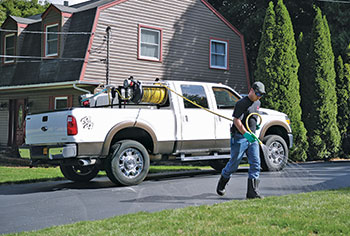
Neglecting to perform spray rig maintenance during the off-season can lead to costly downtime. It also adversely affects a solution’s particle size and coverage.
“Performing maintenance (in the slower months) keeps you from having downtime and keeps your guys spraying until dark instead of working on the equipment,” says Donny Pitts, general manager at Graham Spray Equipment.
Spray equipment experts provide their two cents’ worth about what types of maintenance should be performed on spray equipment in the off-season.
Tanks
- Give tanks a thorough inspection prior to spray season and check for any leaks.
- Clean tanks inside and out at least once per year. Fill the tank with fresh water and pressurize the sprayer with eight to 10 strokes. Open the shut-off and allow water to run through the discharge. This will ensure that the hose, wand and nozzles are rinsed with water as well. Release the pressure and remove the pump. Store the sprayer tank upside down in a dry location with the pump removed.
- Pressurize the tank with soapy water to rinse the hose and discharge assembly, too.
- Ensure the tank is not rubbing on the frame, straps are snug and that there are no loose connections.
- Label the tank or sprayer with the chemical inside of it. If the last chemical wasn’t known, triple rinse it with soapy water.
Engines
- Add a stabilizer to the gas at the end of spray season.
- Change oil per manufacturers’ recommendations, and replace spark plugs and air filters as needed.
Spray guns and nozzles
- Ensure spray guns are properly shut off at the end of the season.
- Be sure the nozzle doesn’t have any cracks and that ice hasn’t damaged it in any way over the winter months. Winterize nozzles each night if the temperature is going to be 36 degrees F or below. Worn spray tips can lead to higher application rates or uneven application.
- Double check that the nozzle type and gallons-per-minute rate correspond. Recalibrate prior to starting the season.
Reels
- On rigs, clean areas where the ground wires meet the truck and the ground before the spray season begins.
- Prior to the start of the season, check the alignment of the chain. If the chain is not aligned properly, there’s an adjustment on the sprocket of the reel motor.
- Periodically grease the swivel at the inlet connection of the hose reel using a small amount of grease each time.
- Check the buttons on the reels to make sure they’re all working well.
Pumps
- Replace wear parts in the pumps, such as diaphragms, as directed by the manufacturer. Having necessary parts in stock will further cut down on downtime.
- Flush pumps with water and purge with antifreeze to prevent damage from freezing at the start of the off-season.
- Check seals for wear or cracking and relubricate before the start of the season.
- Oil pumps by placing 10-12 drops of light oil down the pump rod through the opening in the cover. This can be done periodically throughout the season.
Once all the parts maintenance is complete, test and run the sprayer with water first before adding chemicals or fertilizer.
Sources: Donny Pitts, general manager, Graham Spray Equipment; Anne Miller, technical expert, Chapin; and Rhett Clark, owner and president, Gregson-Clark Spraying Equipment


